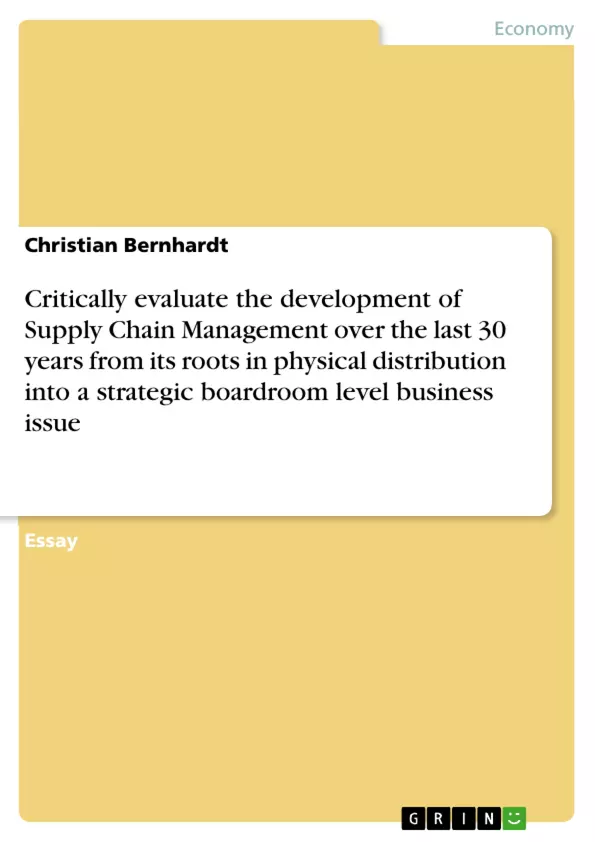‘The real challenge is to improve the capabilities across supply chains significantly in order to drive out cost and realize revenue benefits – fast’ (Gattorna 2003, p.4). This statement both demon-strates the importance for enterprises and emphasizes the complexity of the supply chain require-ments these days. In times of strong competition almost everywhere it is especially important to meet customer needs and thus ‘achieving high levels of service’ (Taylor 1997, p.3). But where does Supply Chain Management (SCM) have its roots and what stands behind it? The purpose of this essay is to critically evaluate the development of SCM. It will both include an explanation of the differences between logistics and SCM and its reasons as well as an explana-tion why supply chain managers are now part of the senior management group. Therefore, the history of physical distribution, logistics and SCM will be mentioned, these three central terms will be defined precisely and four academic strategic approaches will be introduced briefly.
Table of Contents
- Introduction
- Historical evolution and term definitions
- Logistics versus SCM
- Supply chain managers as part of the senior management group
- Conclusion
Objectives and Key Themes
This essay critically evaluates the development of Supply Chain Management (SCM), explaining the differences between logistics and SCM, and exploring why supply chain managers have become part of the senior management group. It delves into the history of physical distribution, logistics, and SCM, providing precise definitions of key terms and introducing four academic strategic approaches.
- The historical development of Supply Chain Management (SCM)
- The differences between logistics and SCM
- The role of supply chain managers in senior management
- The impact of globalization on supply chains
- The importance of customer satisfaction in SCM
Chapter Summaries
- Introduction: This chapter emphasizes the importance and complexity of supply chain management, highlighting the need to meet customer needs in a competitive environment. It sets the stage for the essay's purpose: to critically evaluate the development of SCM.
- Historical evolution and term definitions: This chapter traces the evolution of logistics and SCM, starting from the post-World War II era. It defines key terms like "physical distribution," "logistics," and "SCM" while exploring their historical contexts and highlighting the evolution of each concept.
- Logistics versus SCM: This chapter delves into the relationship between logistics and SCM, outlining four strategic perspectives: traditionalist, relabeling, unionist, and intersectionist. It explores the differences between these perspectives and highlights the key distinctions between logistics and SCM in terms of focus, scope, and collaborative aspects.
Keywords
This essay focuses on the development of Supply Chain Management (SCM), exploring its historical evolution and key differences from logistics. It also examines the role of supply chain managers in senior management, emphasizing the impact of globalization and the importance of customer satisfaction in modern supply chain strategies. Key concepts include physical distribution, logistics, SCM, value chain, globalization, customer satisfaction, and strategic perspectives.
- Citation du texte
- Christian Bernhardt (Auteur), 2012, Critically evaluate the development of Supply Chain Management over the last 30 years from its roots in physical distribution into a strategic boardroom level business issue, Munich, GRIN Verlag, https://www.grin.com/document/205248



